Beaconsfield was the first stop on the coaching route to Oxford. The Universal British Directory of 1792 states that ‘the New Machine passes through Beaconsfield’. Forty years later, the Hope, Union, Telegraph and Champion stagecoaches all passed through the town on their way from London. The Hope carried passengers to Warwick and the Champion to Hereford.
A pillar at the front of the pub, documenting the history of The Hope & Champion.
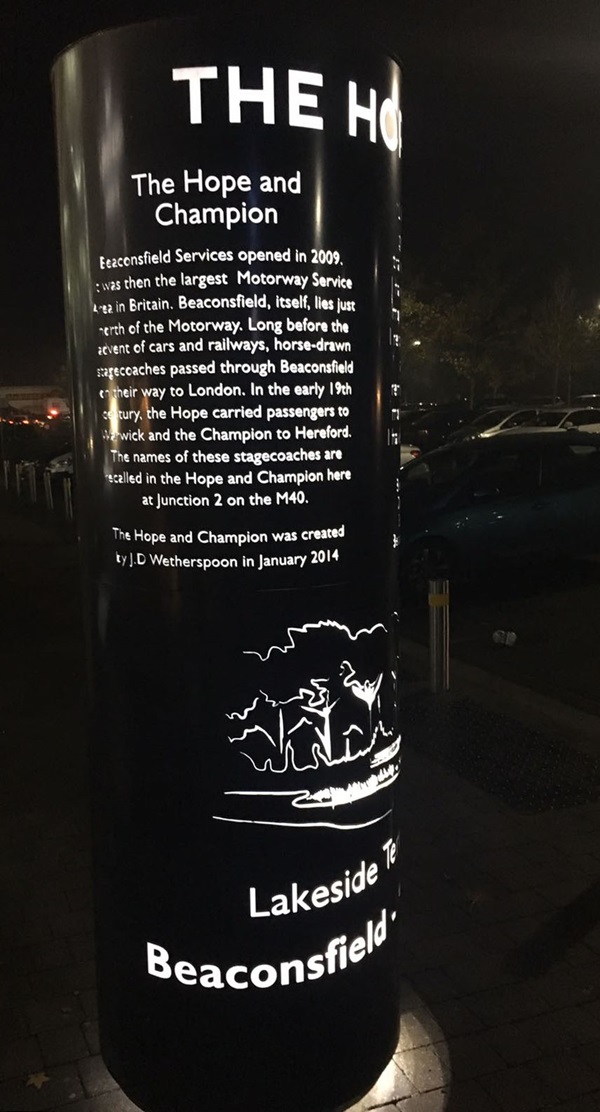
The text reads: Beaconsfield Services opened in 2009. It was then the largest motorway service area in Britain. Beaconsfield, itself, lies just north of the motorway. Long before the advent of cars and railways, horse-drawn stagecoaches passed through Beaconsfield on their way to London. In the early 19th century, the Hope carried passengers to Warwick and the Champion to Hereford. The names of these stagecoaches are recalled in the Hope and Champion here at Junction 2 on the M40.
An illustration and text about the history of The Hope & Champion.
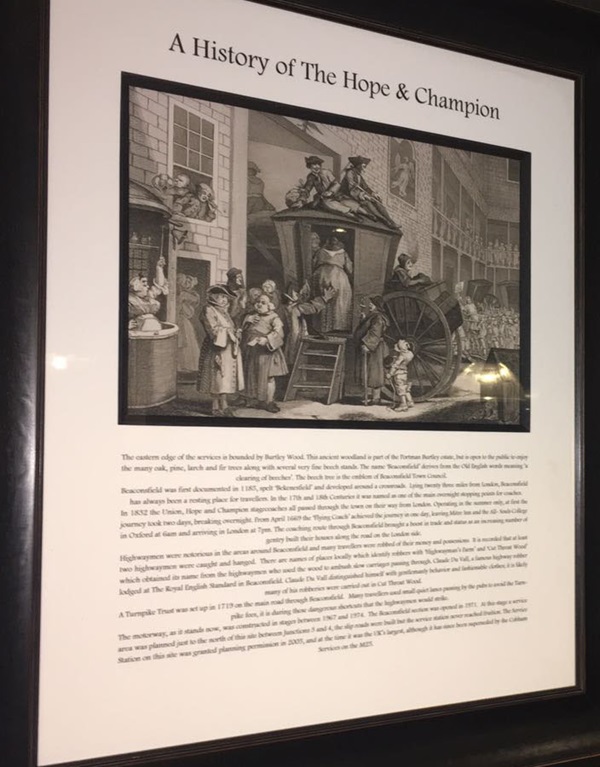
The text reads: The eastern edge of the services is bounded by Burtley Wood. This ancient woodland is part of the Portman Burtley estate, but is open to the public to enjoy the many oak, pine, larch and fir trees along with several very fine beech stands. The name ‘Beaconsfield’ derives from the Old English words meaning ‘a clearing of beeches’. The beech tree is the emblem of Beaconsfield Town Council.
Beaconsfield was first documented in 1185, spelt Bekensfield and developed around a crossroads. Lying twenty three miles from London, Beaconsfield has always been a resting place for travellers. In the 17th and 18th centuries it was named as one of the main overnight stopping points for coaches. In 1832 the Union, Hope and Champion stagecoaches all passed through the town on their way from London. Operating in the summer only, at first the journey took two days, breaking overnight. From April 1669 the Flying Coach achieved the journey in one day, leaving Mitre Inn and the All-Souls College in Oxford at 6am and arriving in London at 7pm. The coaching route through Beaconsfield bought a boost in trade and status as an increasing number of gentry built their houses along the road on the London side.
Highwaymen were notorious in the areas around Beaconsfield and many travellers were robbed of their money and possessions. It is recorded that at least two highwaymen were caught and hanged. There are names of places locally which identify robbers with Highwayman’s Farm and Cut Throat Wood which obtained its name from the highwaymen who used wood to ambush slow carriages passing through. Claude Du Vall, a famous highway robber lodged at The Royal English Standard in Beaconsfield, Claude Du Vall distinguished himself with gentlemanly behaviour and fashionable clothes; it is likely many of his robberies were carried out in Cut Throat Wood.
A Turnpike Trust was set up in 1719 on the main road through Beaconsfield. Many travellers used small quiet lanes passing by the pubs to avoid the turnpike fees, it is during these dangerous shortcuts that the highwaymen would strike.
The motorway, as it stands now, was constructed in stages between 1967 and 1974. The Beaconsfield section was opened in 1971. At this stage a service area was planned just to the north of this site between junctions 3 and 4, the slip roads were built but the service station never reached fruition. The service station on this site was granted planning permission in 2005, and at the time it was the UK’s largest, although it has since been superseded by the Cobham services on the M25.
Photographs and text about Enid Blyton.
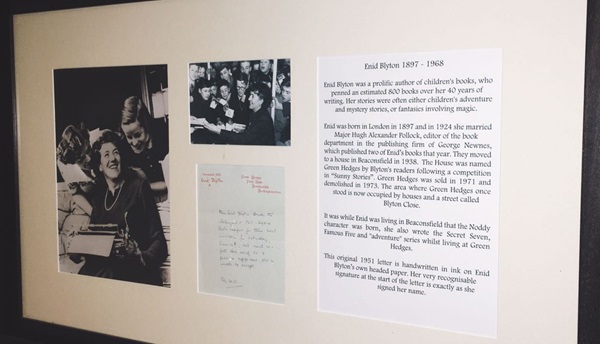
The text reads: Enid Blyton was a prolific author of children’s books, who penned an estimated 800 books over her 40 years of writing. Her stories were often either children’s adventure and mystery stories, or fantasies involving magic.
Enid was born in 1987 and in 1924 she married Major Hugh Alexander Pollock, editor of the book department in the publishing firm of George Newnes, which published two of Enid’s books that year. They moved to a house in Beaconsfield in 1938. The house was named Green Hedges by Blyton’s readers following a competition in Sunny Stories. Green Hedges was sold in 1971 and demolished in 1973. The area where Green Hedges once stood is now occupied by houses and a street called Blyton Close.
It was while Enid was living in Beaconsfield that the Noddy character was born, she also wrote Secret Seven, Famous Five and adventure series whilst living at Green Hedges.
This original 1951 letter is handwritten in ink on Enid Blyton’s own headed paper. Her very recognisable signature at the start of the letter is exactly as she signed her name.
An illustration and text about Benjamin Disraeli, 1st Earl of Beaconsfield, 1804–81.
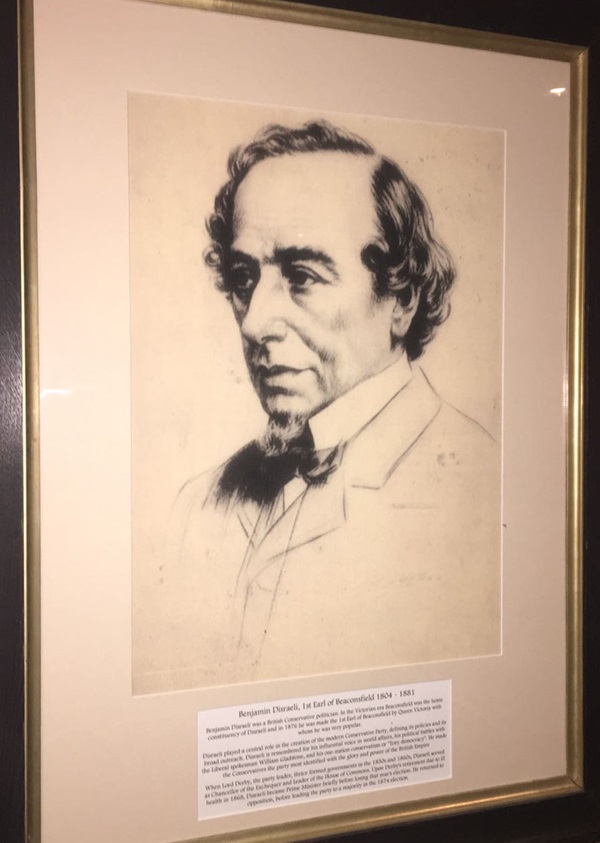
The text reads: Benjamin Disraeli was a British Conservative politician. In the Victorian era Beaconsfield was the home constituency of Disraeli and in 1876 he was made the 1st Earl of Beaconsfield by Queen Victoria with whom he was very popular.
Disraeli played a central role in the creation of the modern Conservative Party, defining its politics and its broad outreach. Disraeli is remembered for his influential voice in world affairs, his political battles with the Liberal spokesman William Gladstone, and his one-nation conservatism or ‘Tory democracy’. He made the Conservatives the party most identified with the glory and power of the British Empire.
When Lord Derby, the party leader, thrice formed governments in the 1850s and 1860s, Disraeli served as Chancellor of the Exchequer and Leader of the House of the Commons. Upon Derby’s retirement due to ill health 1868, Disraeli became Prime Minister briefly before losing that year’s election. He returned to opposition, before leading the party to a majority in the 1874 election.
A photograph of a female golfer finishing her last drive in a tournament at Beaconsfield Golf Club, which was established as the Wilton Park Golf Club, in 1902.
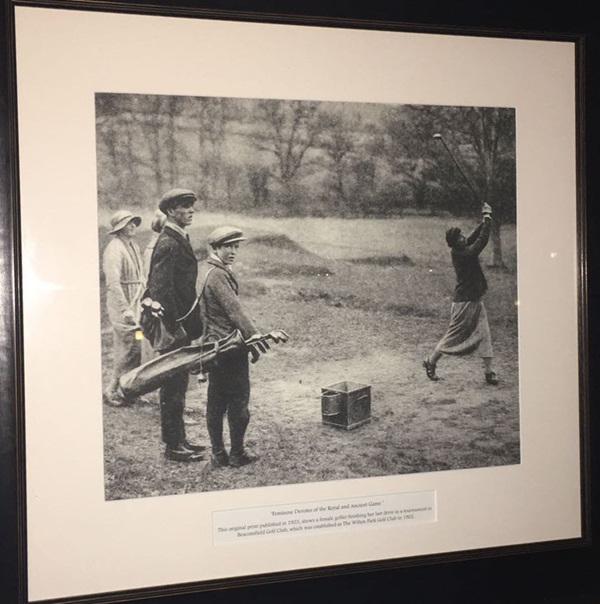
An illustration of a stage coach leaving Oxford.
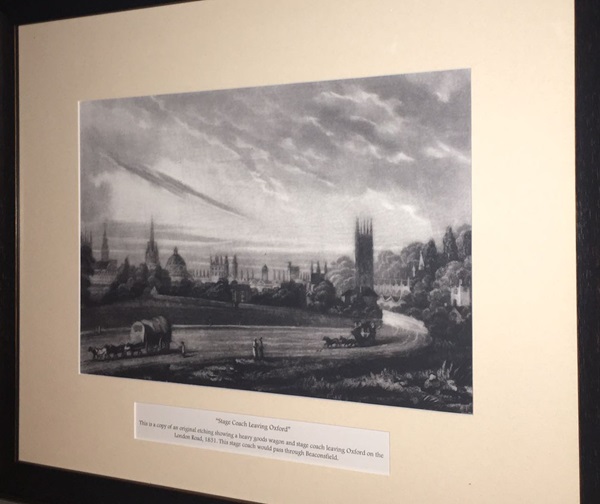
This is a copy of an original etching showing a heavy goods wagon and stage coach leaving Oxford on the London road, 1831. This stage coach would pass through Beaconsfield.
Original coaching horns are on display in the pub.


The original coaching horn positioned above the bar was used to signal the arrival or departure of a post rider or mail coach. Beaconsfield was on the main London to Oxford coaching route and a collection of coaching horns and post horns have been used to create the bespoke hanging sculpture seen on the first floor.
The post horn acted as a modern day siren, the sound travelling some distance ahead and giving warning of a fast approaching mail coach before it could be seen.
A photograph of a GWR Motor vehicle on the way to Beaconsfield.
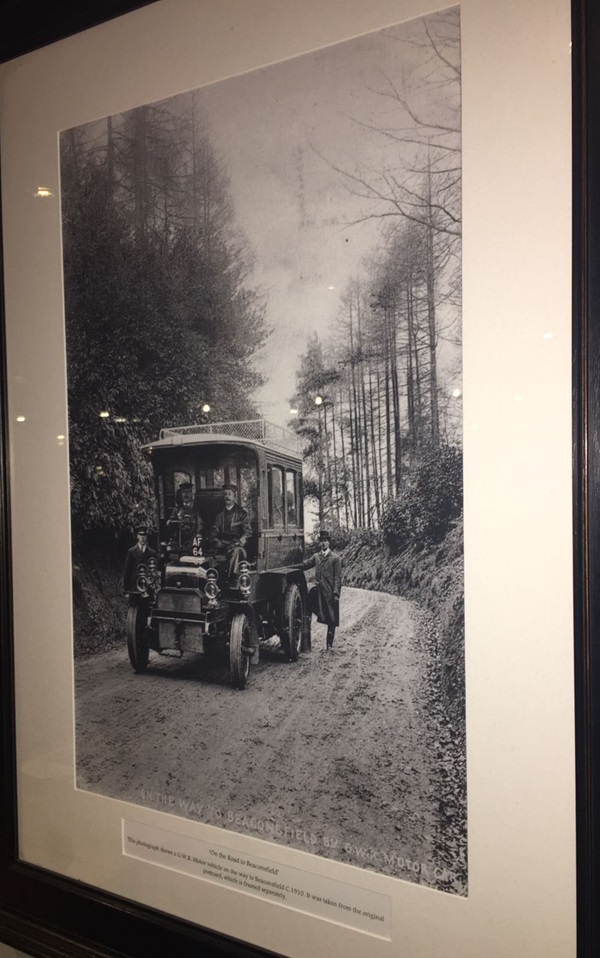
It was taken from the original postcard, which is framed separately.
An aerial photograph of the Beaconsfield Studios, c1930.
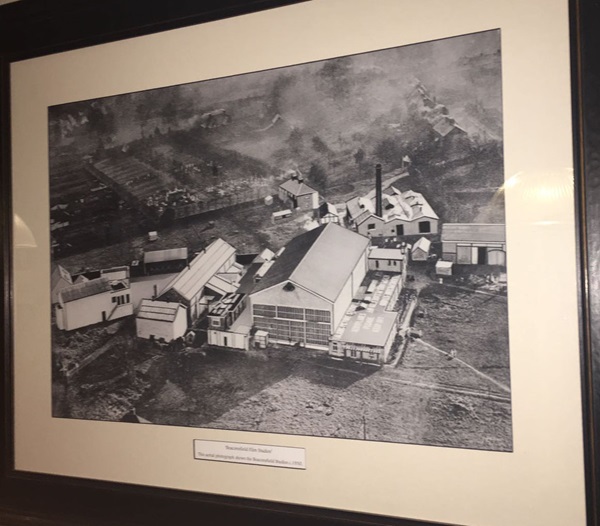
A limited-edition giclée print, entitled Near Ivinghoe Beacon, by Christine Bass.
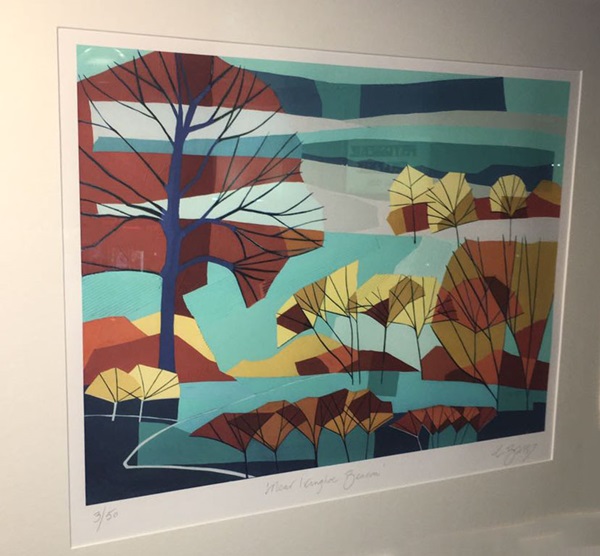
This limited edition giclée print was taken from the original paintings by Christine Bass.
Beaconsfield lies on the southern edge of the Chilterns. Christine paints contemporary landscapes, characterised by strong lines and shapes, flattered planes and the use of vibrant colour. Christine Bass lives and paints in the Chilterns from which she draws much of her inspiration.
A poster and text about Beaconsfield Film Studios and Battle of the Sexes.
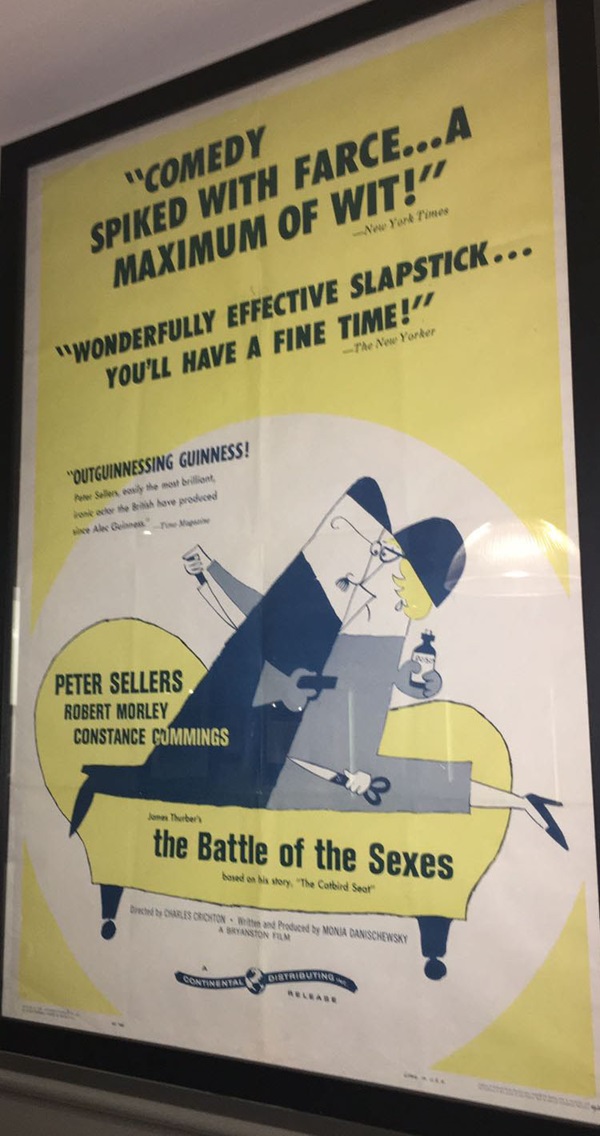
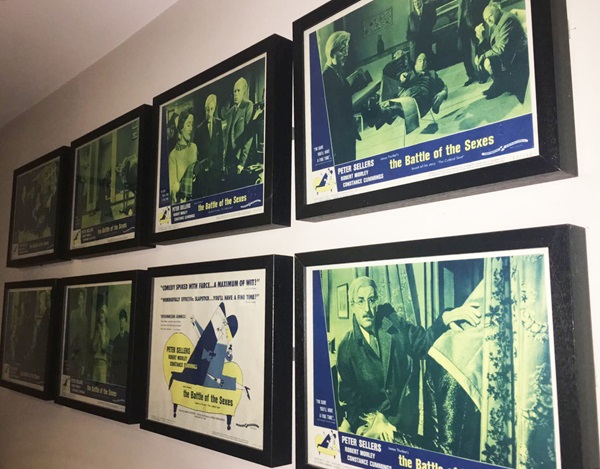
The text reads: Beaconsfield Film Studios (now the National Film and Television school) opened in 1922. The studio recorded Britain’s first all-talking feature film, and operated as a production site for films and TV shows until the 1960s. The studio recorded films starring famous British actors including John Mills and Peter Sellers. This original film poster and series of lobby cards feature different scenes from the comedy film, The Battle of the Sexes which was recorded at Beaconsfield Studios in 1959.
The Battle of the Sexes starred Peter Sellers and on its 1960 release, the film was very warmly reviewed by the New York Times. Peter Sellers plays a quiet clerk working for a Scottish tweed weaving company. Man-eating businesswoman Angela Barrows, played by Constance Cummings, is sent by her US company to Edinburgh to investigate export opportunities and send the weaving company into the 20th century. Sellers has other ideas and a battle between the old and new business methods breaks out.
From 1971 the film studio has been the home of an internationally recognised postgraduate school for film and TV production, famous as the birthplace of characters Wallace and Gromit. The first Wallace and Gromit film in 1982, A Grand Day Out, was started by Oscar winning director Nick Park whilst he was a student at the school.
External photographs of the building – main entrance.

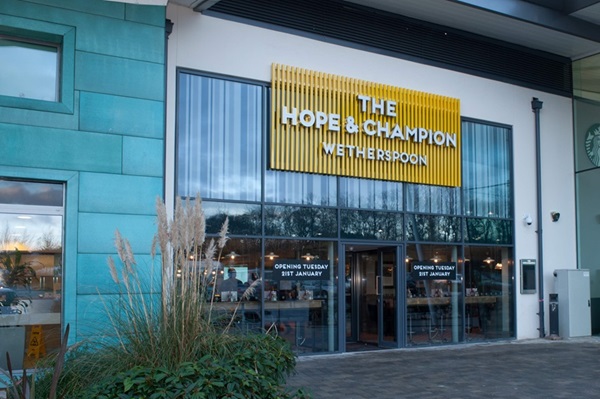
If you have information on the history of this pub, then we’d like you to share it with us. Please e-mail all information to: pubhistories@jdwetherspoon.co.uk